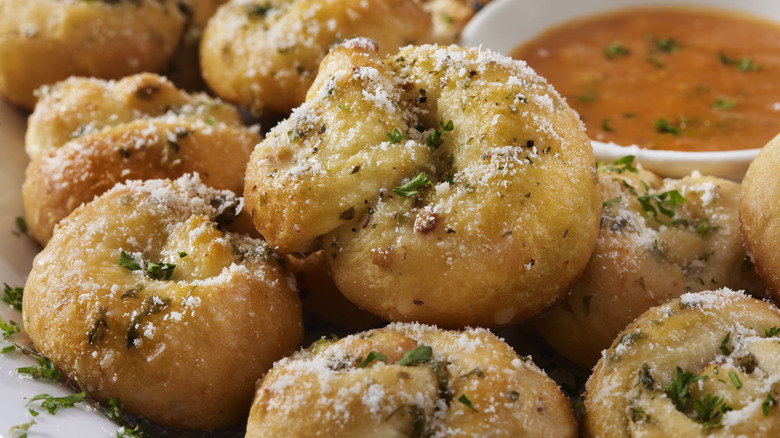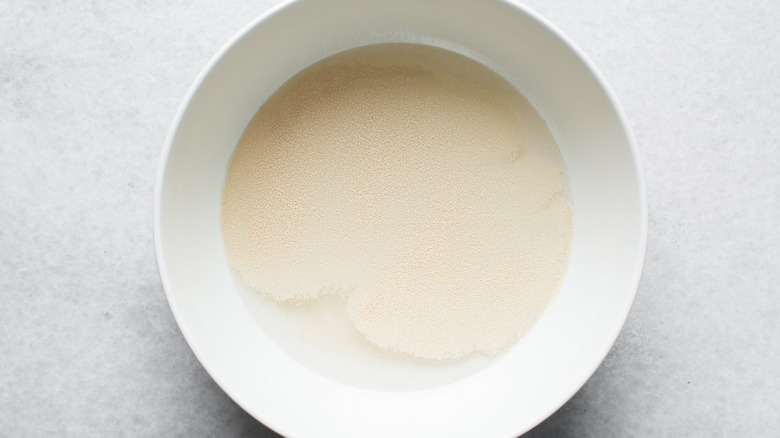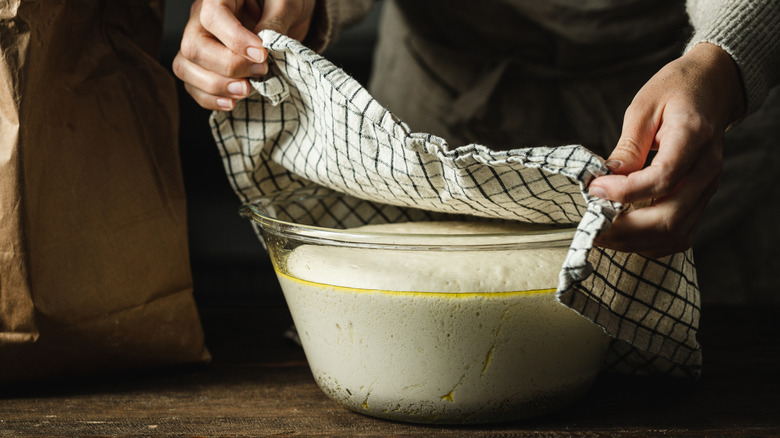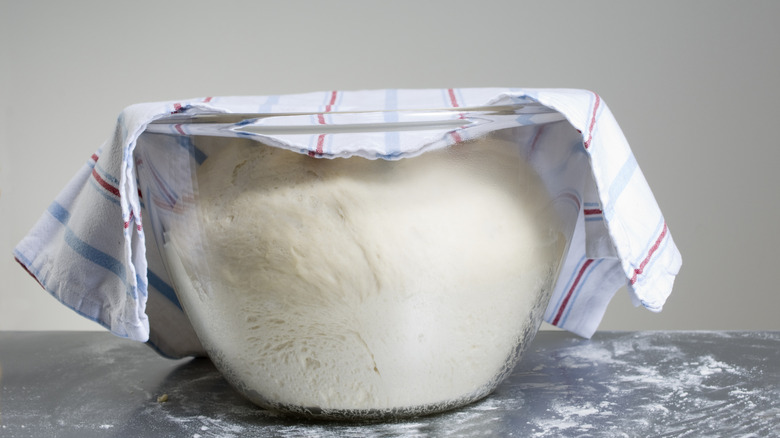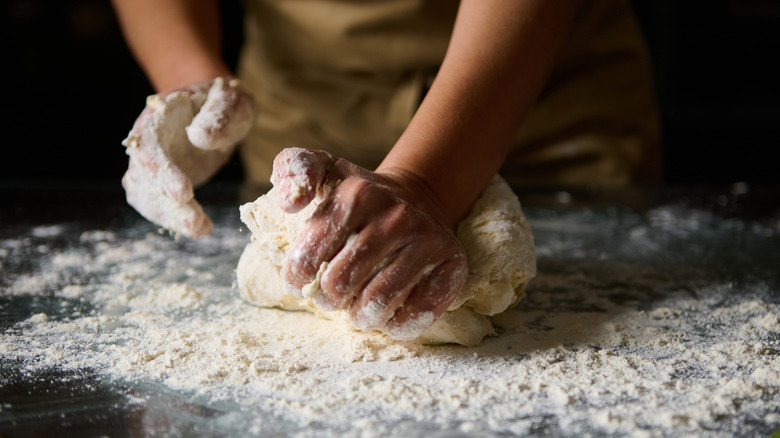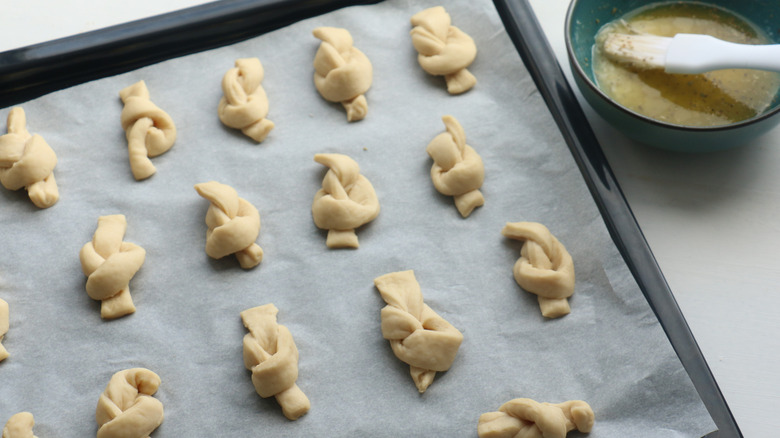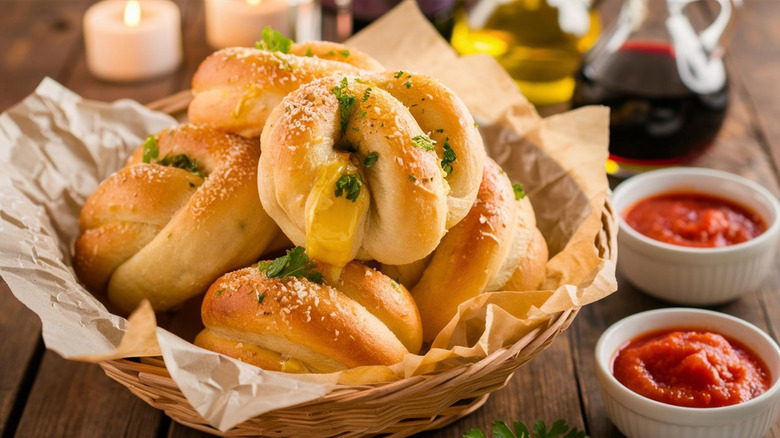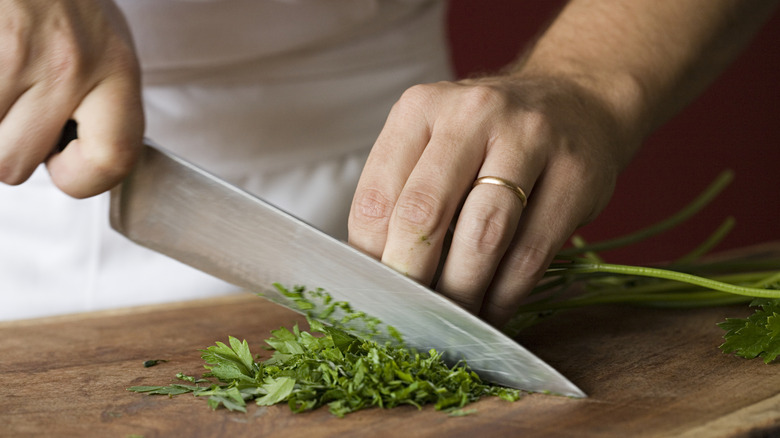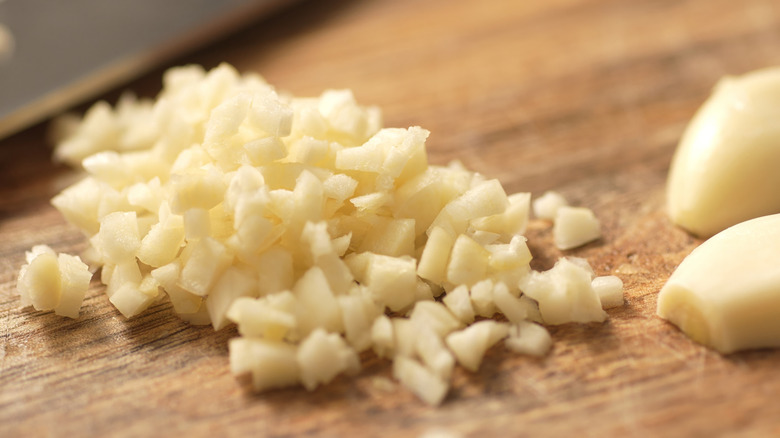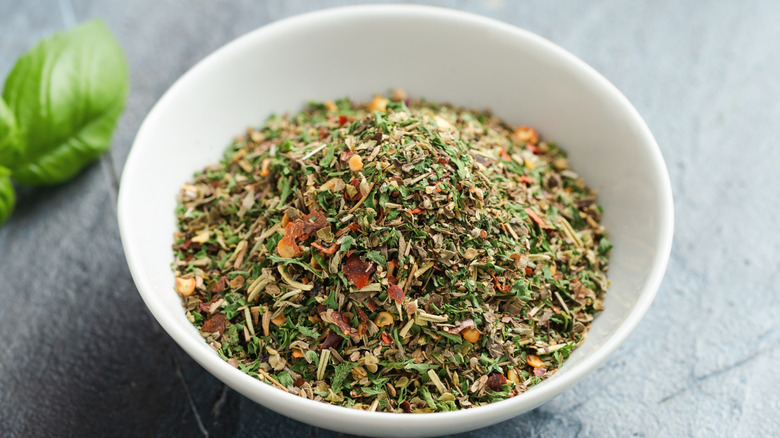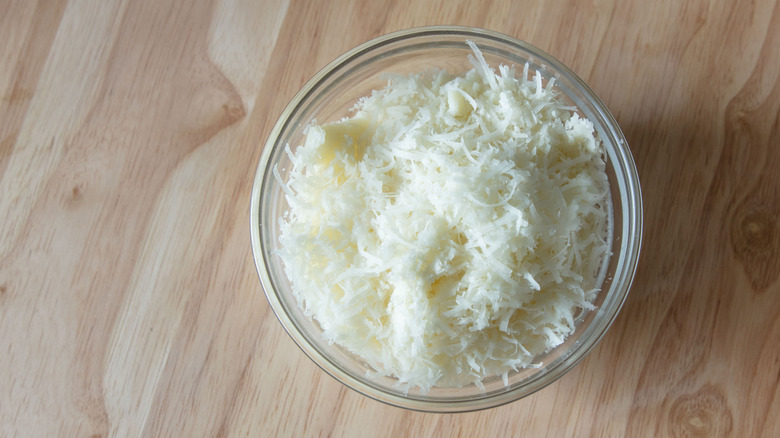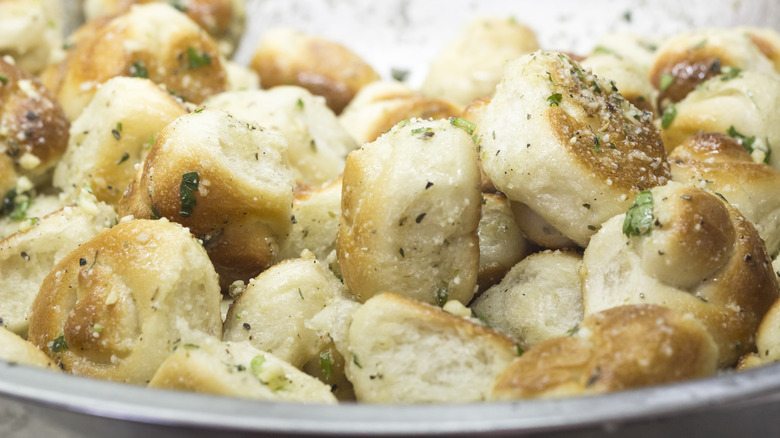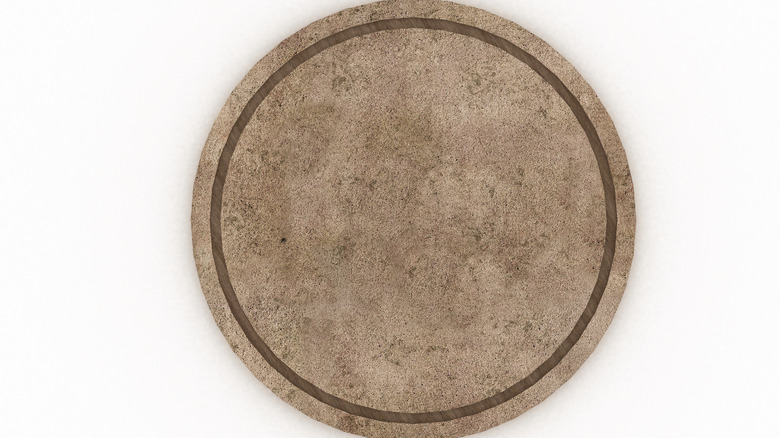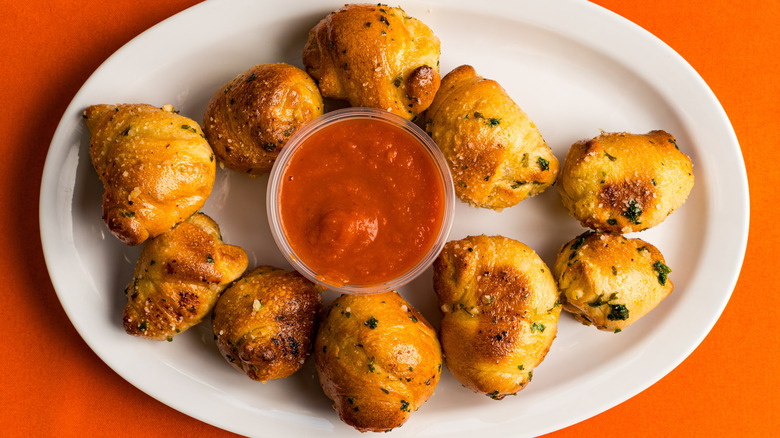Mistakes Everyone Makes With Homemade Garlic Knots
We may receive a commission on purchases made from links.
Garlic knots might just be a little extra you grab with your pizza order but they're always a hit. When they're done right, pizza can end up playing second fiddle to them. But there are some mistakes everyone makes with homemade garlic knots that means they're usually not as good as the ones you get from your favorite pizzeria. Maybe yours turn out soggy or the garlic is burned or they just look super wonky. Whatever your issue, we've been there.
But once you identify the common garlic knot missteps, you can learn how to avoid them. Rather than making knots that are doughy or dense, you get perfectly fluffy bites of goodness, all coated in the most delicious garlic butter you've ever tasted. You might end up learning how to make ones that rival or even surpass your pizza shop faves. Rather than hitting up your go-to delivery app, you'll end up reaching for the flour and yeast when you want killer garlic knots.
Not letting the yeast proof
While you can make shortcut garlic knots with canned biscuits, this dish usually starts with a yeasted dough. And if you want the best version you can make, that's what you need to work with, too. Although you can find dedicated garlic knot recipes, the dough used is generally pizza dough. Originally, these knots would have been made to use up offcuts. So, you can pick your usually favorite pizza dough recipe and go from there.
But the step you shouldn't skip is proofing your yeast. This is a way of testing if these little microbes are active before you proceed with your recipe. If you're wondering how to proof yeast, it basically involves mixing the yeast from your recipe, sugar, and a little slightly warm water and leaving it for 10 minutes. If the yeast bubbles up, it's active and you can proceed with your recipe. If it doesn't, you might need to buy some more.
It might seem like an extra, unnecessary step, especially if you're using instant yeast. However, it can save you time and effort. It's better to know at the start whether or not it's going to do its job and get the dough to rise. If you don't proof it and it turns out that the yeast has perished, you won't know until your dough fails to rise. At which point you will have wasted an hour or so of time and a whole load of flour.
Skipping the rise time
We understand how eager you probably are to get your garlic knots into the oven so you can get them into your belly. But you've got to let them rise. If you try to skip the rising time altogether or underproof your dough, your knots will turn out dense inside instead of perfectly fluffy. You know the saying "good things come to those who wait." Well, you've got some waiting to do.
After kneading your dough, you ball it up in a mixing dough, coat it in olive oil, cover the bowl in a clean, damp dishcloth or plastic wrap, and leave it to its first rise. If you opt for a room temperature rise, this takes around an hour, though it may be slightly longer or shorter depending on factors such as the room temperature and the temperature of the water you use. When it's ready, it should have roughly doubled in size. And, when you poke the dough, it should spring back slowly and leave a small indent. If it springs back quickly, it's under-proofed.
Next, you shape the dough, but after this, the shaped knots need a second proof. Place them on a baking tray, cover them in plastic wrap, and then leave them for another shorter rise. Around 15 to 30 minutes will do the job. Skipping either of these rises will leave you with an inferior texture. It's just not worth it.
Not considering a cold ferment
If you read the subheading before this one, you'll know that your dough needs around an hour at room temperature to rise. This is a perfectly legitimate option but it's a mistake to not at least consider a cold ferment. Yes, it takes more time, but the trade-off is a better flavor.
Cold fermenting your dough is just a fancy way of saying you let it rise slowly in the fridge instead of quickly on the countertop. If you opt for a slow rise, you need to factor in at least 12 hours, but 24 to 48 hours is the sweet spot. Yes, it means that you have to plan ahead but it can save you time on the day you want to make your garlic knots because you just have to let the dough come to room temperature rather than mixing and kneading it.
However, the main benefit of a cold ferment is the flavor. The enzymes in the flour have more time to turn starches into sugars and this gives you a tastier, more complex flavored dough. It's the difference between something good and something great.
Using too much flour when shaping the dough
Shaping garlic knots can be fiddly, especially if your dough is a little sticky. However, you should avoid using too much flour during the process. It can be tempting to add more and more when rolling or shaping dough until it becomes easier to work with but the quantity of flour in a dough recipe is that way for a reason. If you keep adding more while handling the dough, the resulting garlic knots will be tough and dry.
You can use just enough flour to keep the dough from sticking, but if you find yourself reaching for it too much, you might need to rethink things. It could be an issue with the dough. Maybe it needed more kneading to develop the gluten and make it less sticky. Or maybe the recipe has too high a hydration to make good garlic knots. However, if it's just a little tacky and hard to work with, coat the surface and your hands with a little olive oil to prevent sticking. This way, you're not changing the consistency of the dough, you're just making it more oily and delicious.
Making knots from uneven ropes
When shaping garlic knots, you cut the dough into pieces and use your hands to form it into a rope. Then, you tie the rope into a knot and leave it to proof for a second time. You might think it doesn't matter if the ropes you make your knots from are uneven, but it can affect the bake. If some parts are thinner and others are thicker or some ropes are significantly longer than others, the knots won't bake evenly and some will come out overdone or underdone.
To avoid this, first make sure to divide up the dough evenly. Check your recipe to see how many knots it makes. Then, weigh your dough and divide this weight by how many knots you're making. This will tell you how much each piece of dough should weigh. So, if you have 18 ounces of dough and the recipe makes 12 knots, each piece of dough should weigh 1 ½ ounces.
Once you've divided the dough into equal pieces, roll each one into a rope shape with your hands. The ropes should be roughly 8 inches long and half an inch thick. Make sure the thickness is even before you move on to shaping them into knots.
Tying the knot incorrectly
While it doesn't matter too much if your knots are a bit wonky, it can cause them to bake unevenly. Plus, it might leave you stumped and frustrated if you don't understand how to tie the ropes into knots. Learn to knot the dough the right way, then at least you have a base to work from, and if you get it a bit wrong after that, don't sweat it.
Once you have your rope, place it on the counter in a U shape. Then, place one of the arms of the U over the other so the arms form an X. Take the bottom arm and tuck it through the hole and out the other side. You can either leave the knot loose or take the top arm and tuck it underneath so it meets the other one, pressing them together at the underside of the knot.
Once you know how to shape garlic knots, it's fairly simple. It's easier than braiding dough for a challah recipe, for instance. So there's very little reason not to give it a try.
Using dried parsley
Much like garlic bread, garlic knots usually feature a healthy sprinkling of parsley. This livens and brightens them, adding an extra layer of flavor. But, if you're thinking about using dried parsley, that's a serious mistake. You should always use bags of fresh parsley or even cuttings from your herb garden, not something out of a bottle.
You want it to be fresh and lively, not dried and lackluster. Some herbs can be more intense and nuanced when dried, but parsley isn't one of them. Dried parsley doesn't have any of the peppery, grassy, clean flavor of the fresh stuff. It honestly just tastes a bit like dust. Along with basil, it's one of the herbs that I never have on hand dried — it's just not worth using. It's better to go without than waste your time with dried parsley.
Unless you're in a total pinch, you should use fresh parsley: ideally, flat-leaf parsley for a more authentically Italian flavor and a more tender texture. You can adjust depending on your preferences, but around a ¼ cup of minced parsley will do for an average recipe.
Using garlic powder instead of fresh garlic
Although some garlic knot recipes call for it, if you want to make great ones, you need to use fresh garlic not the dried stuff. This is a simple recipe with basic ingredients, so the quality of every component matters. And, they're called garlic knots, after all, so this flavorful allium should be the ingredient that makes them stand out. Without it, they're just knotted dough balls.
If you're wondering what's wrong with garlic powder, it's all in the flavor. This is garlic that's been dehydrated and ground. And while it still has a strong flavor, it doesn't have anywhere near the nuance of a fresh clove. Fresh garlic is sharp with a lot of bite, some sweetness, and that classic savory garlic flavor. The dried version does taste quite savory but has none of the other notes, leaving your knots falling flat.
You should never use minced garlic from a jar, either. We know that it's simpler and saves time but, again, the flavor isn't there. It's muted from hanging out in a jar for months. And the dough you've put all that work into making deserves better than that. Just take a few minutes and mince some cloves of garlic. It's not that hard.
Using Italian seasoning
Italian seasoning is another ingredient that you'll occasionally find in garlic knot recipes that doesn't belong there. It doesn't add anything good to these tasty knots of dough. And, in fact, it can give them a cheap, generic flavor. Instead, you want to be more intentional with the ingredients you use.
A classic Italian seasoning recipe contains equal parts of herbs like basil, oregano, and rosemary that are commonly used in Italian cooking. Occasionally extras like dried red pepper flakes and garlic powder are added. But the point of Italian food is that it's simple and fresh. Nobody in Italy is cooking with an old bottle of mixed herbs. And while garlic knots aren't exactly authentic Italian fare, either, you can elevate them by using quality ingredients.
Fresh garlic, fresh parsley, and a quality olive oil will help you get a flavor worth shouting about, not a generic mixed seasoning. Sometimes more is more. And sometimes it isn't. This is definitely a case where simplicity gives you better results than chucking the entire contents of your spice rack at the problem. So, step away from the Italian seasoning — probably for good.
Skipping the cheese
When you think of garlic knots, you probably imagine pillowy dough, peppery olive oil or rich butter, a hit of garlic, and fresh herbs. If that's all that comes to mind, you're making a mistake by overlooking the cheese. It brings some extra umami flavor to these delicious knots of goodness and helps tie them together with the other ingredients, making them more than just a knotted version of classic garlic bread.
An Italian hard cheese is the way to go here. You're not looking to achieve a melty, gooey finish, like you would with cheddar or mozzarella. To get that true New York City pizzeria flavor, pecorino Romano is the only way to go. This is a sheep's milk cheese with a particularly tangy, salty flavor. It's more intense than Parmesan, so it helps to give your knots a punchy finish. That said, if you want to use Parmesan, Grana Padano, pecorino Sardo, or any other hard cheese of your choosing, go right ahead. It's about finding a flavor you love rather than replicating something specific.
Season the knots by sprinkling the cheese on them at the end, rather than cooking them with it coating them. You want fresh, punchy cheese rather than crispy browned cheese.
Adding the garlic butter before baking
A fairly typical recipe involves letting the knots do their second rise, brushing them with a mixture of melted butter and raw garlic, and then sticking them in the oven. But this can result in butter knots with little chunks of burned garlic all over them. If you want flavorful garlic knots that don't burn, you shouldn't add the garlic butter before baking. The same goes for the parsley. This shouldn't hit the oven but go on raw to keep its flavor.
Wait until you've taken your cooked knots out of the oven before you give them the garlic treatment. This way, you avoid it burning and the nasty bitterness that comes with it. But, won't that leave you with overly sharp raw garlic on your knots? Not necessarily. Rather than letting the garlic cook in the oven, sauté it in butter or olive oil in a pan. This mellows it and gives it that delicious cooked garlic flavor but you get to control the heat and cook time so it doesn't burn. Then, you just toss your cooked knots in the garlic butter or oil, grated cheese, and fresh parsley. Or brush it on with a pastry brush, if you prefer, sprinkling the parsley and cheese on after.
Not using a baking steel or pizza stone
If you want the best texture for your garlic knots, you should use a baking steel or pizza stone. It's not essential, you can cook them on a regular baking sheet, if you like. But you'll be missing out on making the best versions you could. You won't be able to get that true pizza shop texture.
Baking steels and pizza stones retain and evenly distribute heat in your oven, which mimics the high, consistent temperatures of professional pizza ovens. Both materials absorb heat and release it back into the dough, which helps them get crisp and lightly charred.
They can make a big difference in the texture of your garlic knots. The direct heat from a hot baking steel or stone bakes them quickly and evenly. It helps the knots develop a crisp, chewy exterior while keeping the inside tender and fluffy. Otherwise, by the time the outside is that crispy, the inside will be dry.
For best results, preheat your baking steel or stone in the oven for at least 30 minutes before baking. This way, it will be fully heated and ready to work its magic on your garlic knots, baking them to pizzeria perfection.
Doing without the dipping sauce
There's no rule that says you must have a dipping sauce with garlic knots, but why wouldn't you? Honestly, it's a big mistake to miss out on the extra flavor you get from a sauce. Yes, knots are delicious by themselves, but so are french fries and you'd still rather eat them with a pot of mayo or ketchup.
Marinara sauce is a classic choice to go with garlic knots. It's often the sauce they're served with at pizza places because they already have a bunch of marinara sauce sitting around. While the hit of herby tomato is great, there are other dipping sauce choices. A white sauce, such as a garlicky béchamel, is a nice choice to go with your knots. Pesto — whether homemade or store-bought — is also tasty as a dip. Or mix that pesto with a bit of mayo and you have a creamy pesto mayo on your hands. You can experiment, but any classic Italian sauce is a good bet.
